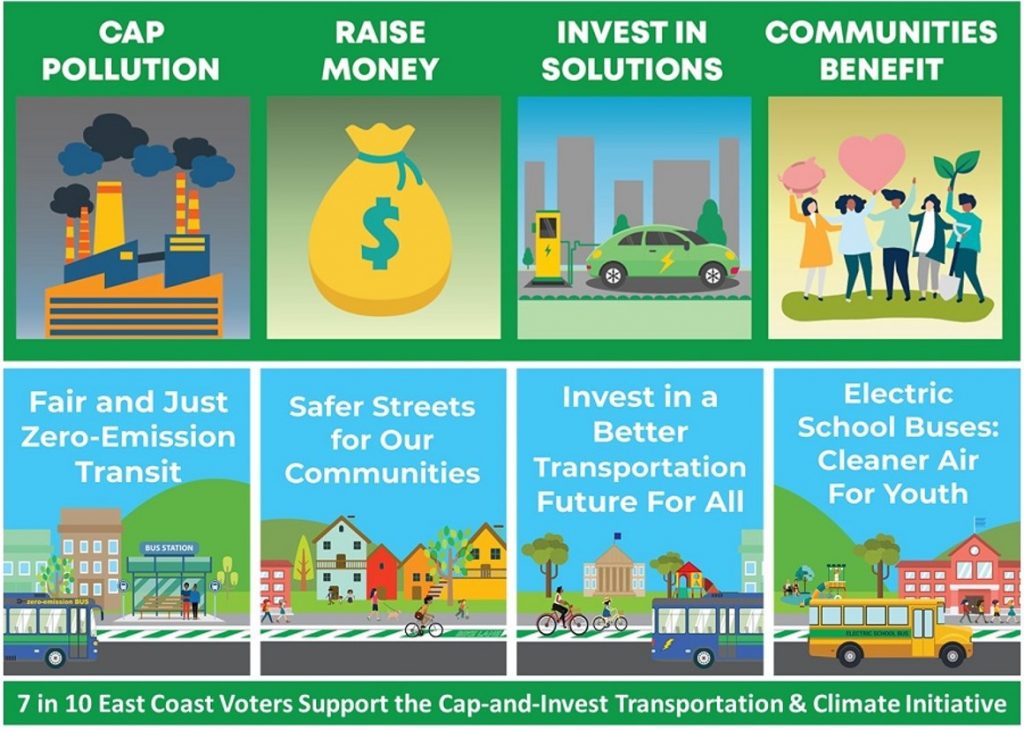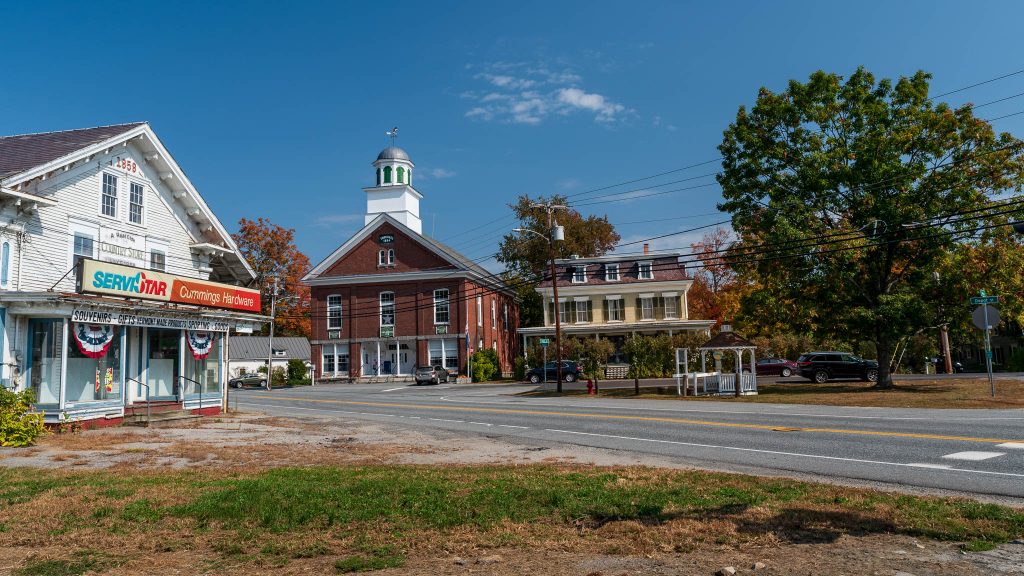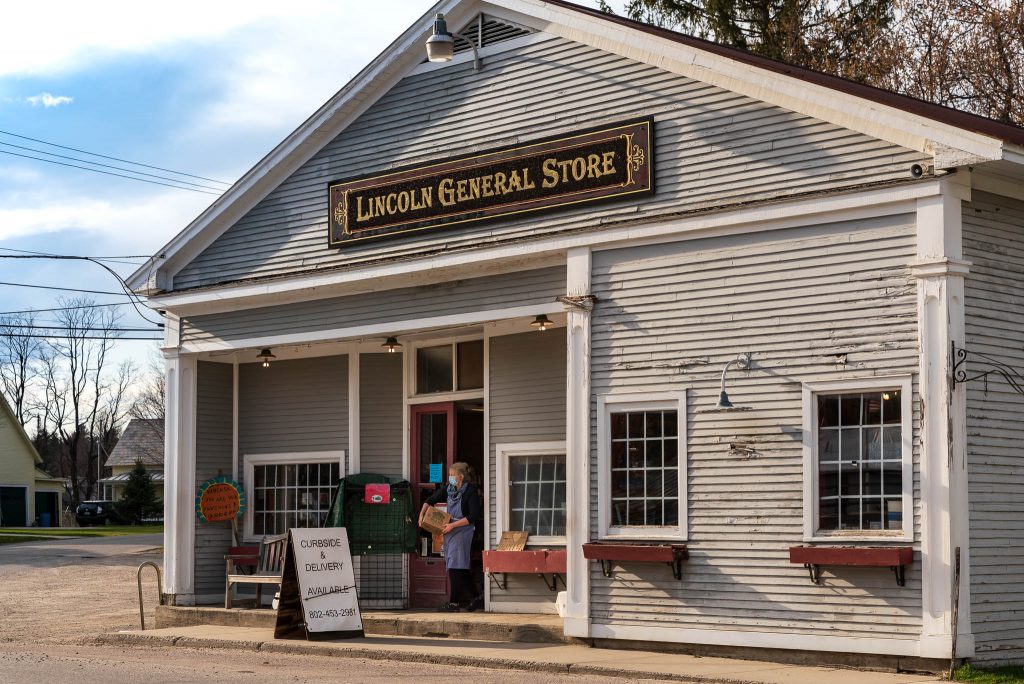By Johanna Miller
“That’s a nice idea, but how are we going to pay for it?”
This phrase will sound familiar to anyone who has worked in public policy, city or state government, or a nonprofit organization. It’s not always easy to convince lawmakers and stakeholders that transportation innovations are worth funding.
Which is why a current opportunity, the Transportation and Climate Initiative (TCI) is so compelling.
What is TCI?

TCI is a regional initiative between eleven northeast and mid-Atlantic states and the District of Columbia. Under this program, states would place a limit on (cap) carbon pollution from the transportation sector (which makes up 45% of Vermont’s carbon emissions) and require fossil fuel companies to pay for the carbon pollution produced by the fuel they sell, by purchasing annual allowances.
The proceeds generated by this plan— estimated to reach up to $6 billion across the region in the first year alone—would then flow back to participating states to be reinvested in cleaner, more efficient, equitable, and more affordable transportation options, ranging from public transportation to sidewalks, paths, and trails that make it safer to walk and bike.
It’s projected that Vermont would receive more than $60 million in revenue as a result of TCI, and according to the terms expected in a forthcoming memorandum of understanding that would govern the program, just over $22 million (35%) of that would be earmarked for communities most burdened by the inequities in the transportation system. That 35% equity threshold is also a minimum; states can decide where TCI revenues go in general and could direct more dollars to support low-income families, disproportionately pollution-impacted neighborhoods, and transit-underserved communities, which include people of color and rural communities.
TCI might not be a household name (yet) but it is the culmination of almost a decade’s worth of work led by state executive branches working in collaboration to shape the program. And Vermonters think TCI makes sense. In a recent poll, 70% of Vermont voters polled by Climate Nexus and the Yale Program on Climate Change Communication (YPCCC) indicated general support for TCI, and 68% said Vermont should join TCI as part of the recovery from COVID-19, believing the program will help jumpstart our economy and create new, good-paying jobs, while reducing air pollution. Only 18% of Vermonters polled opposed the program.
Here are a few ways the revenue raised by this program could help Vermont attain a more sustainable transportation future:
It could bring creative transportation solutions to rural communities.

When people see transportation changes in action and have a chance to try them out, they are more likely to embrace the changes in the longer term. We see it with placemaking (think pocket parks, pop-up spaces, farmers markets) and we see it with transportation (temporary bike lanes, expanded bus routes). That’s why pilot projects are so important.
A cohort of Vermont organizations recently asked: What would it take to combine Vermont’s public, Medicaid, and school transportation into a single electrified public transportation system?
After submitting a “pitch” at the 2020 Energy Action Network (EAN) summit in October (view all proposals here), the group received funding to research and design a pilot project. They will purchase and deploy small electric buses to serve 1-2 of Vermont’s rural school systems and their surrounding communities. No more yellow school buses; instead, a consolidation of services that puts more people in fewer, cleaner vehicles. Read more about the project here.
This idea was fortunate to receive funding from EAN and a Vermont Agency of Transportation Mobility and Transportation Innovations Grant. But today there’s limited funding for other innovative programs, like this one, that could help us rethink how we get around. Revenues from TCI would enable rural communities across Vermont to try new things—and show people what’s possible in their communities.
It could help people with low incomes buy fuel-efficient cars.
The future of driving might be electric, but not everyone can afford to upgrade. Capstone Community Action created MileageSmart earlier this year to provide income-qualifying Vermonters with up to $5,000 towards the purchase of a high-efficiency car.
In order for a vehicle to be eligible, it must be used, sold through a Vermont dealership, and get at least 40 per gallon (or the electric equivalent).
The MileageSmart Program is designed to assist Vermonters who are at or below 80% median income based on household size, determined by Adjusted Gross Income. There are other existing incentives offered by Drive Electric Vermont to assist people in buying electric vehicles.
But for the state to be able to support all the demand for electric vehicles, and more adequately incentivize people to switch to more efficient fuels, we need more frequent funding for more income levels. TCI could provide that funding.
It could expand broadband access to equitably serve people in rural areas, allowing more tele-health, online learning, home-based businesses, and telecommuting for jobs that allow it.

Access to fast, reliable internet is a basic need in the digital age. Yet too many Vermonters lack this amenity, especially in our most rural counties.
As of December 31, 2019, 19.8% of residents in Caledonia County and 32.3% in Essex County were considered “underserved” by broadband access, with Orleans, Orange, and Lamoille counties hovering between 10-13%. When it comes to speed, 82.5% of all Vermonters lacked internet access at the highest tier, 100/100 Mbps. And this was before the COVID-19 pandemic necessitated many daily activities happening exclusively online, exacerbating the hurt of many residents’ lack of access.
States could choose to use revenues from TCI to help residents access broadband internet, making it easier for people—especially in rural areas—to work and learn from home and avoid getting in their car. TCI funds make it more possible to serve rural Vermonters equitably with this important infrastructure (while of course also ensuring that we do not inadvertently promote resource-fragmenting development from new construction).
The connection between high-speed internet and transportation is not intuitive to many. The amount of conversation about broadband within the TCI discussion is a testament to how the program will allow states to think creatively about how to solve root causes of our problems (for instance, people’s inability to telecommute), not just the symptoms we’re familiar with (such as single-occupancy vehicle congestion on our roads). This is particularly important in rural states like Vermont, where we need to ensure that there are real choices for people in all parts of the state, all sizes of communities, and all income levels.
And more…

Of course, TCI funds could also be used for critical, pollution-reducing nearer-term investments, like helping more Vermonters access new and used electric cars (EVs) and building a comprehensive charging network, installing charging stations across Vermont to make it easier to use EVs reliably.
But with a long-term funding source like TCI, and the opportunity to think big about moving toward a cleaner transportation system—even in a rural state—we have the exciting opportunity to think big in the short, medium, and long term about what transportation investments can not only “green” our system, but improve our quality of life.
With our history of progressive policies on clean energy, smart growth, and transportation investment, Vermont is well-positioned to invest TCI dollars thoughtfully so that they benefit Vermonters in general, but particularly Vermonters who have fewer clean transportation choices to begin with.
What’s next?
Planning TCI has been a long process, entailing years of negotiations, and it’s not over yet. There are some upcoming milestones to keep apprised of.
Next week, we anticipate states will roll out a final Memorandum of Understanding (MOU) with exact details of the program. At that point, state governments — governors — will have a chance to sign on to this agreement and, from there, work will begin on operationalizing the program. If states don’t join in December, there will be opportunities to join later. TCI is scheduled to take effect in 2022 and, when rolling, and if constructed well, revenues will be raised to help invest in the diverse, equitable transportation solutions that could serve people and our planet well.
Tell us what you think! Tweet us @VNRCorg and let us know how you’d like to see TCI dollars invested, should the program be adopted in Vermont.




